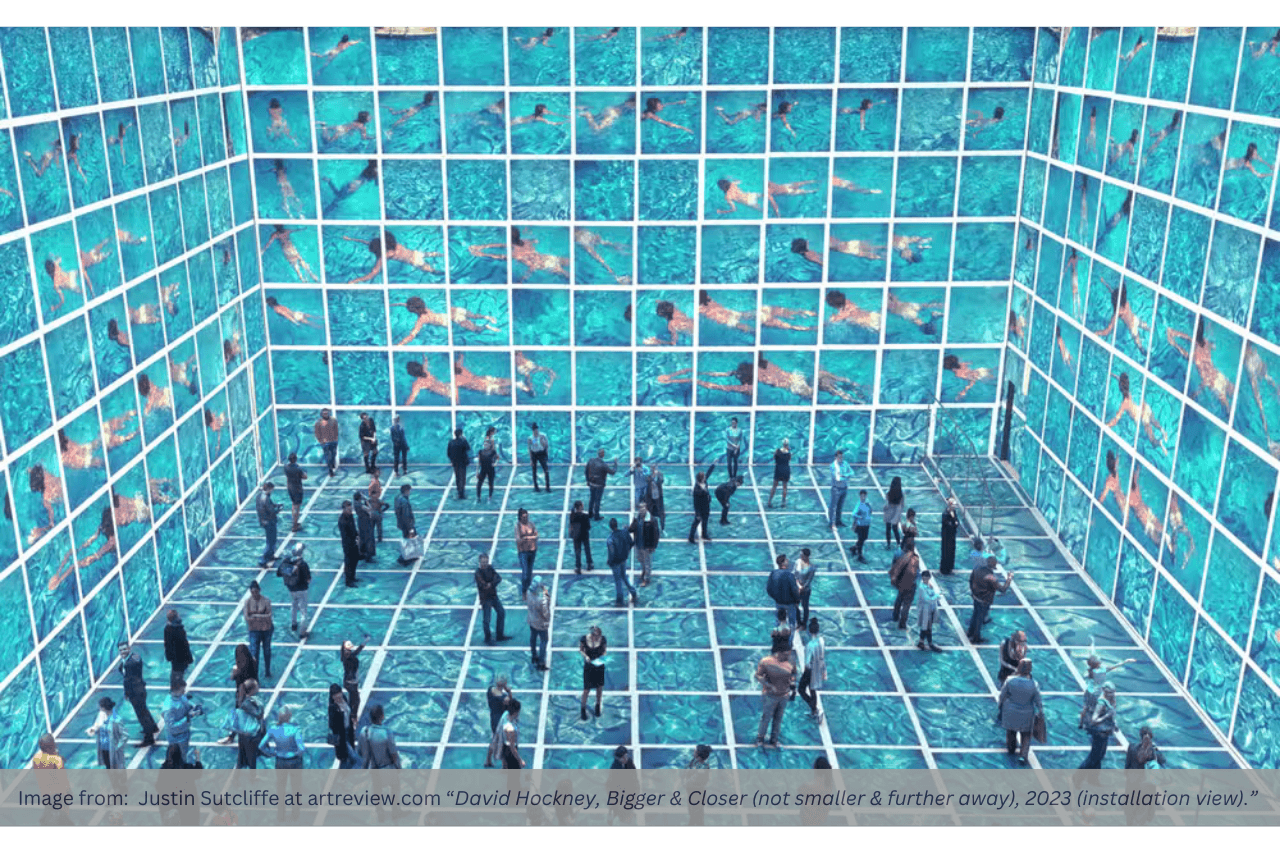Curating an art exhibition involves more than just selecting the right pieces—it is also about how works are displayed to create a captivating experience for visitors.
One common question is: What are the key objectives of a curator when designing and presenting an art display?
Research by Jakub Krukar (2015) says that the spatial design of museum exhibitions serves two purposes: (1) it supports the curatorial narrative of the exhibition, or communicates a predefined message and (2) enhances the viewers’ focus on the artworks or their aesthetic experience.
In an art exhibition, every piece is intentionally placed and thought is given to how the arrangement supports the overall message. Whether it is through positioning, lighting, or sequence of pieces, art curators imbue their decisions with deeper meaning. This is how they facilitate the viewer to engage more meaningfully with the art.
How an art display is organised influences how it is perceived and shapes the viewer's interpretation and emotional response. While there are various art display systems being utilised in exhibitions, this article explores some of the best ways to display art, and highlights the significance behind each method.
- Importance of Art Display Systems
- What are Some Display Techniques Used in Exhibitions?
- White Cube Art Display
- Salon Style Gallery System
- Site-Specific Display
- Immersive Art Display
- Archival Display
- Elevate Your Exhibit with Creative Art Display
- Art Display: Frequently Asked Questions
Importance of Art Display Systems
Carefully planning art displays contributes to greater art recognition. A study by Krukar and Dalton (2020) found that the positioning of artworks in a gallery directly impacts how much attention they receive. The display of art pieces shapes how viewers engage with them and affects how well the artworks are remembered.
For instance, positioning artworks in public or prominent areas can enhance memory recall. This strategic placement encourages viewers to engage with the pieces much longer, allowing them to form connections and recollections of the artworks.
Moreover, the placement of artworks influences how art is appreciated. A thoughtfully designed display can prevent art enthusiasts from feeling overwhelmed by the excessive pieces presented. This allows art to be admired on its own merits, as noted by a sales and marketing expert, Artsy Shark.
With all that mentioned, how artworks are displayed affect how viewers perceives them. Galleries and curators can create meaningful interactions by carefully considering how each piece is displayed.
What are Some Display Techniques Used in Exhibitions?
Considering the importance of using systems in displaying artwork, there have been several techniques and unique approaches that have been popular among curators. This section explores some of the best ways to display art to enhance viewer engagement and appreciation.
White Cube Art Display
The white cube is the most prevalent design utilised by museums and galleries to put art on display. According to an art institution, Tate, this technique features a square or rectangular space with white walls and ceiling-mounted lighting.
This model developed during the growth of abstract expressionism and minimalism in the latter part of the 20th century, and emphased colour and light. Each artwork is placed against white walls, allowing every piece to stand alone–leaving no room for distraction.
The white walls are filled with artwork –framed and unframed, forming the illusion of frames within frames. The room is bright and evenly lit, creating a neutral setting that directs full attention to the artwork.
Take the White Cube, a contemporary art gallery in Bermondsey and Mason’s Yard, London. The art gallery in London is styled with clean and stark white walls, as demonstrated in the photo below.
The gallery has high ceilings and muted lighting, creating an atmosphere that isolates the art on display. The white cube approach encourages individual contemplation and let the viewers focus solely on the artworks as they engage with them on a deeper level.
Salon Style Gallery System
Unlike the white cube concept which emphasises minimalism and individual focus, the salon style, according to the Gallery System, showcases grouped artworks that cover entire walls.
This art display hanging system was inspired by the Paris Salon – an art exhibition in the late 17th century featuring a collection of artworks by students at the Royal Academy, amongst other masters, as noted by The Art Institute of Chicago.
Today’s salon wall takes inspiration from this traditional style, promoting the dynamic and crowded arrangement of artworks, highlighted by an online art platform, Saatchi Art.
This gallery-style art hanging is exemplified in Room 18 of the National Portrait Gallery (NPG), presenting personalities from art, literature, drama, music and other forms of performance, including martial arts, said National Portrait Gallery.
The magazine The World of Interiors describes the display of art paintings hung from floor to ceiling, all neatly lined in single rows around the walls with only an inch of space between each piece.
The top-to-bottom style emphasises abundance. It showcases the curator’s ability to create a visual dialogue among different artworks. It was specifically designed to impress and overwhelm viewers with various art on display.
Read more: How to Style Your Home Like an Art Gallery
Site-Specific Display
A site-specific art display is a concept where the artwork’s physical location and environment are integral to its identity.
The concept originated in the 1960s as artists increasingly focused on the physical settings of their work, notably how different contexts could transform and deepen the viewer’s experience of the artwork, said an online art marketplace, Artsy.
A prime example of this type of art show display is Desert X AlUla, an exhibition set in the ancient desert valley oasis of AlUla, Saudi Arabia. The setting is home to Saudi Arabia’s first inscribed world heritage property, the Hegra Archaeological Site.
According to the official website of AlUla, participating artists were invited to delve into concepts of the unseen and the inexpressible and encouraged to explore what lies beyond the surface. This approach creates new interactions with the landscape, as their artworks were integrated into three distinct locations across AlUla.
The Desert X AlUla exhibition showcases art as a medium to broaden viewers’ understanding of the region’s importance by stimulating the curious and imaginative aspects of human nature, as highlighted by an art organisation and publisher, Contemporary Lynx.
This type of art show display served as an outlet that allowed visitors to question, explore, and learn about the historical site while engaging with contemporary artistic expressions.
Immersive Art Display
Immersive art is an art display that turns viewers into active participants, allowing them to engage with the artwork through their senses rather than simply observing it.
This art display system leverages technology such as projections, Virtual Reality (VR), and Augmented Reality (AR) which blurs the boundaries between space and the artwork.
One of the first known examples of immersive art can be found in the cave paintings created by a Paleolithic tribe in Southern France. According to FutureLearn, the tribe used bright mineral pigments to cover the walls and ceilings with large, mythical images of bulls, stags, horses, felines, and other animals.
Archaeologists suggest that sandstone lamps and fireplaces were used to illuminate the space while producing a flickering, moving effect that brought these majestic animals to life.
A prime example of an art show that employs immersive art display is David Hockney: Bigger & Closer (not smaller & further away). The Guardian, a global news organisation, highlights the innovative space of Lightroom as it uses 1,408 speakers, 28 projectors, and a digital canvas that spans approximately 108 million pixels.
This art show offers visitors an immersive experience as the surrounding room lights up and changes as they explore six chapters of the artist's work. The show features a specially composed score by Nico Muhly, creating an intriguing synergy between movement and music within the landscape.
In this way, technology has revolutionised art displays – using advanced projections and a cutting-edge sound system to bring the artist's vision to life.
Archival Display
In addition to displaying art paintings, incorporating archival displays is an effective way to showcase preserved materials from archives. These can include documents, photographs, letters, audiovisual recordings, and other historical items, offering a deeper narrative alongside the art.
The archivist Ernst Posner argued that the Sumerians established the earliest known archives around the mid-fourth millennium B.C. These records, inscribed with cuneiform characters on clay tablets, primarily served to document commercial transactions and property ownership.
In galleries and museums, archival materials are often presented behind glass or enclosed in protective transparent cases, highlighting the object’s historical significance and fragility.
The exhibition Sculptors' Papers was presented in the Archive Gallery, featuring a collection of artworks from private collections.
According to the Henry Moore Institute, the Archive of Sculptors' Papers includes a rich collection of photographs, letters, drawings and sketchbooks, all carefully displayed in glass cases (see photo below). Film, digital records, and even the tools and costumes that reflect the working lives of hundreds of sculptors were also part of the collection.
In this context, archival displays revealed the sculptor's creative process by providing access to various archival materials. While their primary purpose was to document the artist's journey, they also allowed viewers to traverse time, exploring the sculptor's work and ideas through these documents.
Elevate Your Exhibit with Creative Art Display
The way art pieces are displayed in exhibitions significantly impacts the viewer’s experience and the overall effectiveness of the presentation.
By employing various techniques – such as white cube, salon-style, site-specific, immersive, or archival display systems – curators can create an engaging experience that resonates with the viewers.
While these methods serve to enhance the aesthetic appeal of the artworks, it also invite viewers to connect more deeply with the art and its context.
In essence, intentional display choices elevate exhibitions, creating meaningful connections that inspire admiration of the artistry.
Art Display: Frequently Asked Questions
1. What are the different art display methods?
Art display methods refer to various techniques and strategies used to showcase artworks in exhibitions or galleries. These methods include white cube, salon-style, immersive, site-specific, and archival display.
2. How to display a piece of art?
To display a piece of art effectively, consider its context, size, and lighting. Use appropriate mounting techniques and frames that complement the artwork while ensuring the surrounding environment enhances its visual impact, as noted by Rise Art.
3. How to hang an art exhibit?
According to Beyond Print, a general guideline is to hang artworks at eye level, around 150 cm from the floor, to ensure they are easily visible and comfortable for the average viewer.
Organise Your Art Collection with MyAssets
Whether an aspiring curator or an art collector, one can streamline the consolidation of their pieces with tools like MyAssets.
MyAssets is a complete asset management platform that streamlines the organisation of art pieces, management of different collections, and monitoring details about art such as canvas dimensions; making it easier to plan and mount exhibits.
This platform allows its users to organise artworks by grouping them into similar themes, styles, or artists, which is essential for creating a cohesive art display.
With features designed to catalogue details such as title, artist name, and provenance; MyAssets enables users to view, organise, and manage their entire collection from anywhere.
Take the first step towards a well-organised collection with MyAssets' 14-day free trial.











